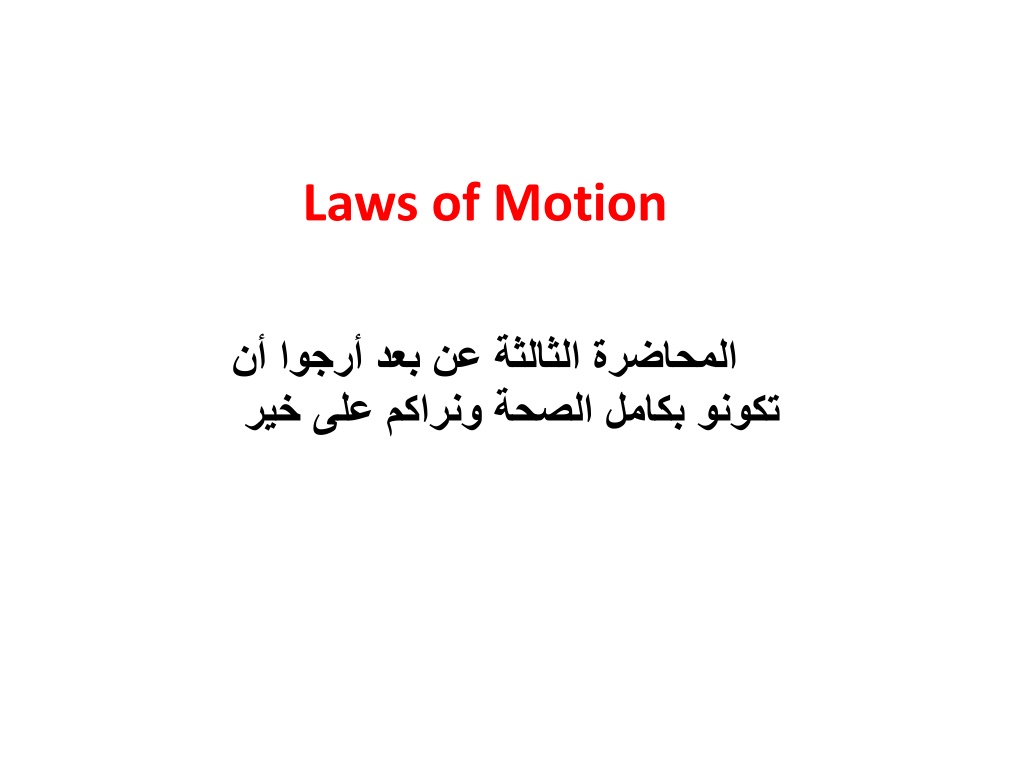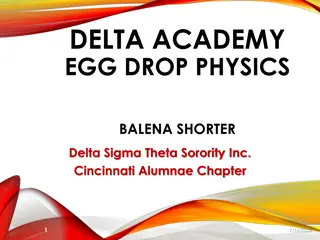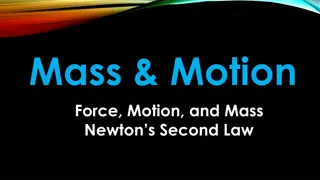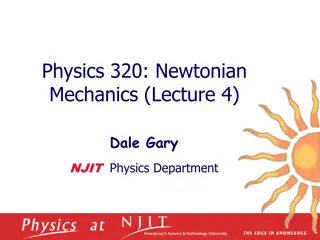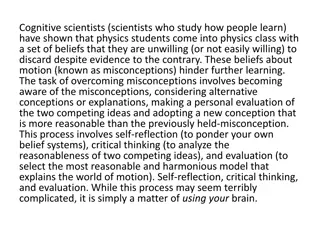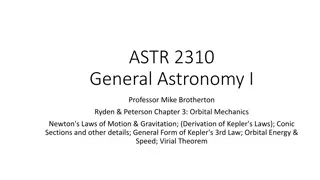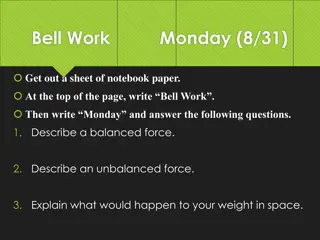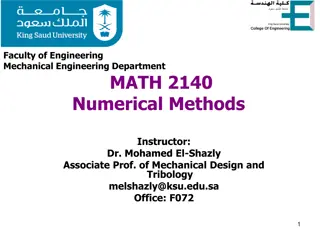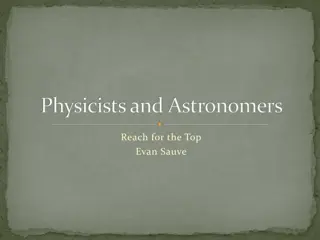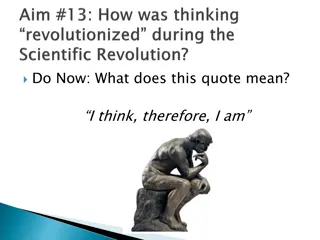Understanding Newton's Laws of Motion
Dynamics is governed by Newton's three fundamental laws of motion. These laws, formulated by Newton, describe the behavior of objects in motion and at rest. Key terms such as mass, weight, momentum, force, and inertia are crucial in understanding these laws. Rigid bodies, which consist of fixed particles, play a role in applying Newton's laws. Newton's First Law states that objects remain in their state of motion unless acted upon by an external force, while the Second and Third Laws focus on momentum and action-reaction pairs. Newton's Second Law allows for measuring force and establishing dynamic equations.
Download Presentation

Please find below an Image/Link to download the presentation.
The content on the website is provided AS IS for your information and personal use only. It may not be sold, licensed, or shared on other websites without obtaining consent from the author. Download presentation by click this link. If you encounter any issues during the download, it is possible that the publisher has removed the file from their server.
E N D
Presentation Transcript
INTRODUCTION The entire system of dynamics is based on three laws of motion, which are the fundamental laws, and were formulated by *Newton. Like other scientific laws, these are also stated in the mathematical forms which agree with actual observations. IMPORTANT TERMS The following terms, which will be mostly used in this chapter, should be clearly understood at this stage : ) ( 1. Mass. mass are kilogram,tonne etc. It is the matter contained in a body. The units of ) ( 2. Weight. towards the centre of the earth. The units of weight are the same as those of force i.e. N, kN etc. It is the force, by which the body is attracted
) ( 3. Momentum. a body. It is expressed mathematically as: It is the quantity of motion possessed by Momentum = Mass Velocity. The units of momentum depend upon the units of mass and velocity. In S.I. units, the mass is measured in kg, and velocity in m/s, therefore the unit of momentum will be kg-m/s. ) ( 4. Force. also, and may be defined as any cause which produces or tends to produce, stops or tends to stop motion. The units of force, like those of weight, are N, kN etc. It is a very important factor in the field of dynamics ) ( 5. Inertia. offers resistance to the change of its state of rest or uniform motion. It is an inherent property of a body, which
RIGID BODY A rigid body consists of a system of innumerable )particles. If the positions of its various particles remain fixed, relative to one another (or in other words, distance between any two of its particles remain constant), it is called a solid body. It will be interesting to know that in actual practice, all the solid bodies are not perfectly rigid bodies. ) ( NEWTON S LAWS OF MOTION Following are the three laws of motion, which were enunciated by Newton, who is regarded as father of the Science. 1. Newton s First Law of Motion states, 2. Every body continues in its state of rest or of uniform motion, in a straight line, unless it is acted upon by some external force.
NEWTONS LAWS OF MOTION 2. Newton s Second Law of Motion states, The rate of change of momentum is directly proportional to the impressed force, and takes place in the same direction, in which the force acts. 3. Newton s Third Law of Motion states, To every action, there is always an equal and opposite reaction. NEWTON S SECOND LAW OF MOTION This law enables us to measure a force, and establishes the fundamental equation of dynamics. Now consider a body moving in a straight line. Let its velocity be changed while moving. Let m = Mass of a body,
u = Initial velocity of the body, v = Final velocity of the body, a = Constant acceleration, t = Time, in seconds required to change the velocity from u to v, and F = Force required to change velocity from u to v in t seconds. Initial momentum = mu and final momentum = mv Rate of change of momentum According to Newton s Second Law of Motion, F = ma = Mass Acceleration. In S.I. system of units, the unit of force is called newton briefly written as N.
MOTION OF A LIFT Consider a lift (elevator or cage etc.) carrying some mass and moving with a uniform acceleration Let m = Mass carried by the lift, a = Uniform acceleration of the lift, and R = Reaction of the lift or tension in the cable, supporting the lift, Here we shall discuss the following two cases as shown in Fig. (a) and (b) : 1. When the lift is moving upwards. 2. When the lift if moving downwards.
1. When the lift is moving upwards We know that downward force due to mass of the lift = mg and net upward force on lift, F = R mg ...(i) We also know that this force = Mass Acceleration = m.a ...(ii) From equations (i) and (ii), R mg = ma R = ma + mg = m (a + g) 2. When the lift is moving downwards In this case, the net downward force, which is responsible for the motion of the lift. = mg R ...(iii)
From equations (ii) and (iii), ma = mg R R = mg ma = m (g a) The mass carried by the lift (or mass of the operator etc.) will exert a pressure on the floor of the lift. Whereas tension in the cable will be given by the algebraic sum of the masses of the lift and mass carried by the lift. Mathematically. (When the lift is moving upwards), then the pressure exerted by the mass carried by the lift on its floor = m2 (g + a) m1 and tension in the cable = (m1 + m2) (g + a) m2 Where : m1 = Mass of the lift and m2 = Mass carried by the lift.
Example 24.16. An elevator of gross mass 500 kg starts moving upwards with a constant acceleration, and acquires a velocity of 2 m/s, after travelling a distance of 3 m. Find the pull in the cables during the accelerated motion. If the elevator, when stopping moves with a constant deceleration from a constant velocity of 2 m/s and comes to rest in 2 s, calculate the force transmitted by a man of mass 75 kg the floor during stopping. Solution. Pull in the cable, during accelerated motion: First of all consider motion of the elevator with a constant acceleration. In this case, initial velocity (u) = 0 (because it starts from rest) ; Final velocity acquired (v) = 2 m/s and distance travelled (s) = 3 m. Let a1 = Constant acceleration.
Force transmitted by the man during the decelerating motion Now consider motion of the elevator the decelaration (i.e. retardation). In this case, initial velocity (u) = 2m/s ; Final velocity (v) = 0 (because it comes to rest) ; time (t) = 2 s and mass of man (m2) = 75 kg
DALEMBERTS PRINCIPLE* It states, If a rigid body is acted upon by a system of forces, this system may be reduced to a single resultant force whose magnitude, direction and the line of action may be found out by the methods of graphic statics. We have already discussed, that force acting on a body. P = ma ...(i) where m = mass of the body, and a = Acceleration of the body. The equation (i) may also be written as : P ma = 0 ...(ii) It may be noted that equation (i) is the equation of dynamics whereas the equation (ii) is the equation of statics. The equation (ii) is also known as the equation of dynamic equilibrium under the action of the real force P. This principle is known as D' Alembert s principle.
Example 24.17. Two bodies A and B of mass 80 kg and 20 kg are connected by a thread and move along a rough horizontal plane under the action of a force 400 N applied to the first body of mass 80 kg as shown in Fig. The coefficient of friction between the sliding surfaces of the bodies and the plane is 0.3. Determine the acceleration of the two bodies and the tension in the thread, using D' Alembert s principle.
Solution. Given : Mass of body A (m1) = 80 kg ; Mass of the body B (m2) = 20 kg; Force applied on first body (P) = 400 N and coefficient of friction ( ) = 0.3 Acceleration of the two bodies Let a = Acceleration of the bodies, and T = Tension in the thread. First of all, consider the body A. The forces acting on it are : 1. 400 N force (acting towards left) 2. Mass of the body = 80 kg (acting downwards) 3. Reaction R1 = 80 9.8 = 784 N (acting upwards)
4. Force of friction, F1 = R1 = 0.3 784 = 235.2 N (acting towards right) 5. Tension in the thread = T (acting towards right). Resultant horizontal force, P1 = 400 T F1 = 400 T 235.2 = 164.8 T (acting towards left) We know that force causing acceleration to the body A = m1a = 80 a and according to D' Alembert s principle (P1 m1a = 0) 1 64.8 T 80 a = 0 or T = 164.8 80a ...(i) Now consider the body B. The forces acting on it are : 1. Tension in the thread = T (acting towards left) 2. Mass of the body = 20 kg (acting downwards) 3. Reaction R2 = 20 9.8 = 196 N (acting upwards) 4. Force of friction, F2 = R2 = 0.3 196 = 58.8 N (acting towards right)
Resulting horizontal force, P2 = T F2 = T 58.8 We know that force causing acceleration to the body B = m2a = 20 a and according to D' Alembert s principle (P2 m2a = 0) (T 58.8) 20 a = 0 or T = 58.8 + 20 a ...(ii) Now equating the two values of T from equation (i) and (ii), 164.8 80 a = 58.8 + 20 a 100 a = 106 or a = 106/100 = 1.06 m/s2 Ans. Tension in the thread Substituting the value of a in equation (ii), T = 58.8 + (20 1.06) = 80 N Ans.
NEWTONS THIRD LAW OF MOTION RECOIL OF GUN According to Newton s Third Law of Motion, when a bullet is fired from a gun, the opposite reaction of the bullet is known as the recoil of gun. Let M = Mass of the gun, V = Velocity of the gun with which it recoils, m = mass of the bullet, and v = Velocity of the bullet after explosion. Momentum of the bullet after explosion = mv ...(i) and momentum of the gun = MV ...(ii) Equating the equations (i) and (ii), MV = mv Note. This relation is popularly known as Law of Conservation of Momentum.
Example 24.19. A bullet of mass 20 g is fired horizontally with a velocity of 300 m/s, from a gun carried in a carriage ; which together with the gun has mass of 100 kg. The resistance to sliding of the carriage over the ice on which it rests is 20 N. Find (a) velocity, with which the gun will recoil, (b) distance, in which it comes to rest, and (c) time taken to do so. Solution. Given : Mass of the bullet (m) = 20 g = 0.02 kg ; Velocity of bullet (v) = 300 m/s; Mass of the carriage with gun (M) = 100 kg and resistance to sliding (F) = 20 N (a) Velocity, with which the gun will recoil Let V = velocity with which the gun will recoil. We know that MV = mv 1 00 V = 0.02 300 = 6 (b) Distance, in which the gun comes to rest Now consider motion of the gun. In this case, initial velocity (u) = 0.06 m/s and final velocity (v) = 0 (because it comes to rest) Let a = Retardation of the gun, and s = Distance in which the gun comes to rest.
